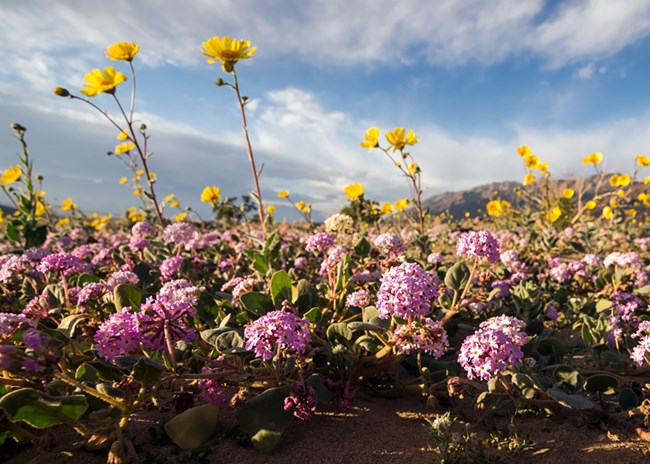
Kurt Moses 
NPS / Kurt Moses Predicting a Good Bloom YearA good wildflower year depends on at least three things: Well-spaced rainfall throughout the fall, winter, and spring, sufficient warmth from the sun and lack of drying winds.

Typical Bloom Windows In Death Valley National park, most of the showy desert wildflowers are annuals, also referred to as ephemerals because they are short-lived. Oddly enough, this limited lifespan ensures survival here. Rather than struggle to stay alive during the desert’s most extreme conditions, annual wildflowers lie dormant as seeds. When enough rain finally does fall, the seeds quickly sprout, grow, bloom and go back to seed again before the dryness and heat returns. By blooming enmasse during good years, wildflowers can attract large numbers of pollinators such as butterflies, moths, bees and hummingbirds that might not otherwise visit Death Valley.
Past Wildflower SeasonsThis was an incredibly good bloom year. Abundant rain in the summer of 2023 and early months of 2024, combined with cool spring temperatures led to above-average blooms throughout the park. While a park-wide superbloom did not occur, there were localized areas of extensive blooms including fields of desert gold in Panamint Valley and hillsides covered in globe mallow near Dantes View. Flowers sprouted in many locations often lacking vegetation such as alluvial fans along CA Hwy 190 and many flowering shrubs such as creosote were extra green and vibrant. This year was an above average bloom year. Monsoon rains from the previous summer, coupled with a cool winter and spring showers, contributed to beautiful flowers. Wildflowers showed up late this year (Valley floor: late March-early April, Mid Elevations: April, High Elevations: mid-May-June) but put on quite a show. The best blooms were at mid and high elevations, including along Daylight Pass Rd, North Highway, Big Pine Rd and Emigrant Canyon Rd. Some of the most common flowers observed included: desert gold, various species of phacelia, desert paintbrush, globemallow, lupine, mariposa lillies and brittlebrush.
Although we received rain in July, it came too early; rain is usually required in the fall to produce a large bloom. This fall was not only dry, but also hot, with above average temperatures in November. However, several rain events in December thoroughly wet the soil, which was good news for wildflowers, leading to an average bloom this spring.
A dry fall, with rain/snow starting the last week of December 2020, led to very sparse blooms at low elevations in the spring.
|
An official website of the United States government
Here's how you know
Official websites use .gov
A
.gov website belongs to an official government
organization in the United States.
Secure .gov websites use HTTPS
A
lock (
) or https:// means you've safely connected to
the .gov website. Share sensitive information only on official,
secure websites.

